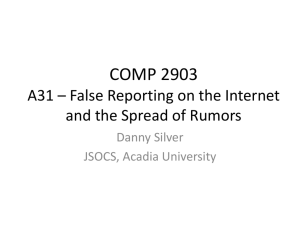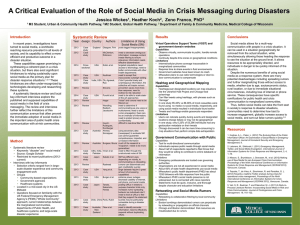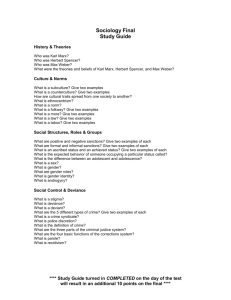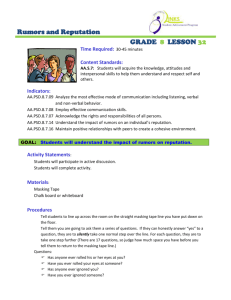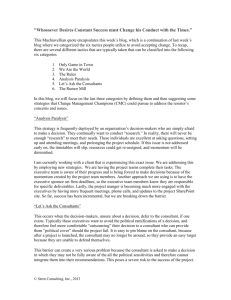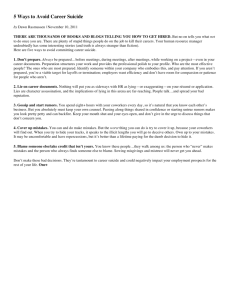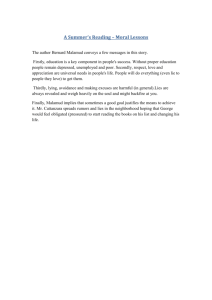What Effect Do Rumors Have on Publicly Traded Sports Teams
advertisement
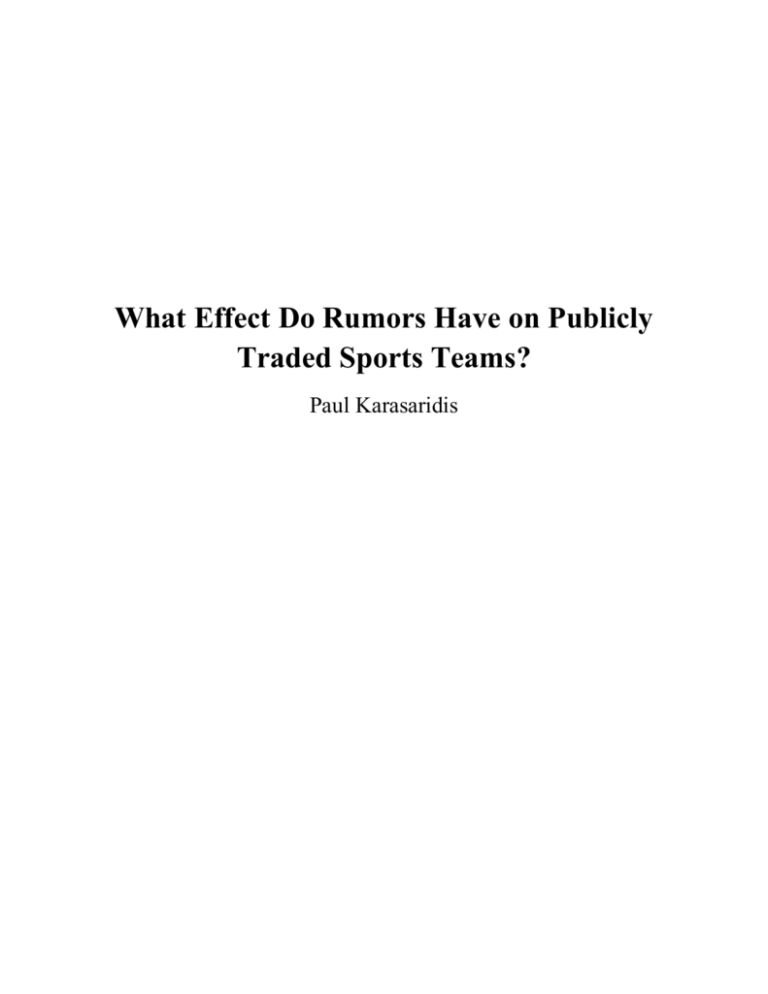
What Effect Do Rumors Have on Publicly Traded Sports Teams? Paul Karasaridis What Effect Do Rumors Have on Publicly Traded Sports Teams? Abstract This paper explores the effects of rumors on stock prices. It targets publicly traded soccer teams to see what impact rumors of players transferring, in and out of teams, has on their respective stock returns. A total of 56 rumors are being used in the analysis. An event study is conducted around the dates of each transfer rumor in order to examine what types of abnormalities exist in the returns of the stock. To further investigate this study, a cross sectional analysis is being performed to see whether player reputation, player status, and future validity of the rumors had more of an effect on the stock’s returns. My statistical analysis indicates that abnormal market returns occur with strong statistical significance between 3 and 1 day before the publication of the transfer rumors in the sample. Univariate tests show no statistical significance in any of the cross sectional analyses performed. A regression controlling for each factor, in addition to the team’s ranking, also showed no statistical significance. Market value, used as a control variable for a player’s popularity in the regression analysis, was found to have a statistically significant relationship with abnormal returns. 2 1. Introduction This study’s premise is to observe how rumors, a type of news, affect the market. I am interested in discovering what effect important rumors pertaining to a publicly traded entity have on the prices of its stock. The other aspect of my research is to understand how certain rumors may affect abnormal returns greater, or less than others. To study this phenomenon, I took an interest in the stocks of publicly traded sports teams; for my research I am analyzing 6 top performing European soccer teams traded in various markets. For my sample, I am choosing a certain type of rumors that I think will have a great impact on the teams involved. These are rumors of players transferring in and out of teams. Thus, I ask: Do transfer rumors affect stock prices? How do certain rumors affect stock prices? The arrival of public news has a distinct impact on the stock market. Information released about a company has varying effects on its stock price based on what kind of news it is. Historically, the publication of news has had major economic implications as well. Evidence of this can be seen in the failure of major investment bank Lehman Brothers, whose dealings were part of the economic collapse in 2008. After news revealed that Lehman Brothers was in talks with a South Korean firm over buying a stake in their company, shares of the bank plummeted 45% (Agence France-Presse, 2008). News of investment banks looking for buyers set off a chain reaction of fear within the investing community. As a result, investors were selling their holdings to save themselves from losses that they thought would inevitably ensue. Learning how news impacts the stock market is very integral to the investing community, not only on a small scale, but on a larger economic scale as well. According to financial theory, the efficient market hypothesis advocates that stock prices should reflect all available information. (Bodie, Kane, and Marcus, 2011). Fama (1976) 3 describes three different forms of this hypothesis: weak, semi-strong, and strong. Weak form efficiency implies that stock prices mirror information that can be realized by analyzing its historical data (such as past prices). Semi-strong form efficiency suggests that all available public information is already reflected in the price of a stock. The strong form hypothesis indicates that stock prices include all public, as well as private information. Governmental institutions work to strive for a semi-strong form efficient market. These institutions, such as the Security Exchange Commission in the U.S., keep a fair market in which no single investor should have any private information that would lead to an unfair advantage in dealings. Adding to this, a traditional “news model” assumes that agents incorporate every portion of publicly obtainable news into the pricing of an asset. (Stadtmann, 2006). This would imply that the arrival of new, unexpected, information changes the outcome of a stock’s price accordingly. Behavioral finance is a newer area of study that strives to make sense of various decisions made by investors. This field consists of three different aspects: psychology, sociology, and finance. (Schindler, 2007). The psychology part focuses on the biases that occur while individuals define their preferences and, given their beliefs, make certain decisions. The sociology aspect of behavioral finance focuses on the interactions between individuals in the market. This field of study has aided in providing to us evidence that various irrational behaviors by individuals has a great influence on the pricing of securities. One feature of behavioral finance is the study of rumors. This is because rumors are heavily influenced by psychology and sociology. From a psychological standpoint, a rumor may invoke emotions after an individual performs irrational behaviors, such as those of fear and stress. They are also involved sociologically because a rumor cannot evolve without communication between individuals. (Schindler, 2007). 4 Rumors can be viewed as a substitute for news. When there is a lack of news in financial markets, future projections are created to fill in gaps of information. When these projections are communicated within the investing community, a rumor is born. This is the classic way in which rumors are created. (Schindler, 2007). For example, if a CEO says that their company is interested in merging with another, but does not designate with whom, rumors may develop. These substitutes for news will evolve and spread throughout the market if the information they provide is stimulating and of major importance. According to Schindler (2007) there are two ways in which rumors are analyzed by behavioral finance. One is at the individual level in which the procedure taken to make an investment decision is analyzed. The other is the aggregate or market level which focuses on how irrational behaviors by investors lead to disproving the Efficient Market Hypothesis. In the past, rumors have been categorized in various ways. Koenig (1985) separates rumors by domain, public or market, and by their emergence, general or specific (See Figure 1). For example, if an intergovernmental organization is agreeing to increase oil production, this would be affecting the public by domain, and the emergence would be considered public as oil prices will affect the general population. Additionally, if two banks are said to be interested in merging, these rumors are directly affecting the market by domain and are specific in emergence as the focus is on the business of the two financial entities. Kapferer (1996) further categorized rumors by understanding their origin. According to this author, rumors can either emerge spontaneously, or are deliberately provoked, and their source may derive from an event, from a detail, or pure fantasy (See Figure 2). To further explain this categorization, he describes the emergence of rumors as either spontaneous (an unprompted hypothesis generated by society that has a high likelihood of being true) or deliberately provoked (a statement made as a way to urge 5 a specific future action). He remarks that rumors invented from pure fantasy, those of an unclear origination, are not generally believed by the market. This study aims to look at how rumors affect the market. To study this aspect of behavioral finance, I am analyzing the transfer rumors of 6 top performing European soccer teams traded in various markets. Motivation to study such stocks lies in the sport’s international appeal and global attention. Additionally, there have been only a handful of studies done on publicly traded soccer teams. I am choosing a certain category of rumors with which I think to have a great impact on the teams involved to perform this study. These are rumors of players transferring in and out of teams, which can be categorized as specific in emergence and market by domain. I use key indications in these specific market rumors in attempt to sort out rumors derived from pure fantasy. I am conducting an event study around the date in which these rumors are published by various media sources. The event study is being prepared to recognize whether these transfer rumors generate abnormal returns around the publishing date (or “event date”). I am then conducting a cross sectional analysis to see what types of rumors may be causing abnormalities if they exist. I am separating rumors in three different ways: higher ranked players versus lower ranked players (player reputation), transfers of players into teams versus out of teams (player status), and rumors that ended up being true versus those that turn out to be false (validity of rumors). Lastly, I am running a multivariate regression using these previous factors, and I will be including each team’s yearly ranking to look for a relationship of significance between them. I find that there are abnormal returns of strong statistical significance between three and one days before the event date of the publishing of the rumor. Univariate tests show no significance in differences between higher and lower ranked players, player transfers in and out, 6 and true and false rumors. Additionally, my multivariate analysis shows no significance in a relationship between each, even whilst controlling for each player’s team rankings. Market values, which were used as an additional variable to control for a player’s “popularity,” seem to have some type of significant correlation with abnormal returns. The following portions of this paper will go into detail on how the event study is being conducted, and the methods that were used. The next section is a detailed description of literature reviews conducted on particular financial research relating to rumors, and the various studies on publicly traded soccer teams. Following that is a detailed description of my hypotheses, null and alternative. Subsequently, a description of the data, an empirical analysis, and conclusions on what was found will be marked in the latter half of the study. 2. Literature Review Learning how rumors affect trading prices was one item I wanted to gain an understanding in before performing my analysis. Van Bommel (2003) performed a combined study on insider trading and the spreading of rumors. He creates a model consisting of a small investor or trader (who acts as a rumormonger) with a set number of followers. This study shows us that the informed investor is able to increase their profits by spreading inaccurate rumors to followers in order to manipulate market prices. Van Bommel then controls for three possible avenues the informed investor can take: honest, bluff, or cheat. The cheating strategy lead to profits as the investor unwinds his position opposite to the information sent. The author also finds that if followers recognize that an informed investor has the motivation to cheat, they will not trust the rumors that are spread thereafter. Eventually, bluffing and cheating lead to a 7 loss in reputation among followers. The informed investor was forced away from bluffing and cheating because losses in followers lead to the inability to manipulate prices. In striving to realize which types of rumors would have a more measurable effect on the returns of these sports teams, I looked towards previous analyses performed. Researchers Stadtmann (2006) and Wu (2011) both found that unexpected sporting successes of European soccer teams had an impact on trading prices. They use betting odds as predictions to soccer matches; as a result, unexpected match results lead to abnormal returns proven with very strong significance. Both of these studies also used a reverse news model in their analyses to see whether news of major corporate governance events affected stock prices. In both studies, it was found that these news items do in fact interfere with stock prices for their respective teams; examples of these events include talk of investors buying major stakes in a soccer team and a team planning to issue a 100 million euro bond. Another study by Bernile and Lyandres (2011) found that returns are linked to match results. This analysis of a top European soccer team found that wins generate near zero returns, and losses of the soccer team lead to negative ones. As apparent in the previous model conducted by Van Bommel, rumors can have measureable effects on prices. Stadtmann and Wu also provide to us that corporate governance events do interfere with stock prices. Additionally, the prior studies by Bernile and Lyandres on soccer teams also helped me in understanding that team performances do have a quantifiable effect on stock prices. One factor that has major implications on a team’s match performance is the players they have. Therefore, I saw it fit to analyze rumors of player transfers provided by mass media sources in an attempt to uncover any abnormal returns in stocks of top European soccer teams. 8 The signing of players is followed closely by all types of media. Actual transfers do not occur until a transfer window has started which varies from country to country. In Europe, these windows officially open and close around the same time; the winter transfer window lasts about the month of January, and the summer transfer window lasts from about the end of June, to the end of August. Throughout the year however, rumors of possible transfers swirl around newsletters, websites, and television reports; some turn out to be true and the player actually signs for that team, while others are found to be false and the player remains on his original team and possibly signs a new contract extension. The theory of this research is that the initial publication of player transfer rumors should provide abnormalities in the returns because match results are tied to team performance as proven by prior literature. 3. Hypotheses Development Rumors of player transfers should in theory have an effect on publicly traded soccer teams because teams buy new players in order to increase match performance. The premise of my hypothesis is that I believe transfers of soccer players lead to an abnormal reaction in the stock prices of the team’s involved. Whether this reaction is positive or negative is something that is uncertain. Thus I am first testing the following: H0: Transfer rumors have no effect on the stock prices of the publicly traded sports teams involved. H1: Transfer rumors have an effect on the stock prices of the publicly traded sports teams involved. 9 To further test my initial hypothesis, I test several real measureable factors about these rumors that can possibly lead to abnormal effects in the stock’s price. These are: higher ranked players versus those of lower ranking (player reputation), whether the player is rumored to be transferring in or out of the team (player status), and whether the rumor is found to be true or false (validity of the rumor). Monthly player rankings are being used, as a popularity factor, to examine if more talented players generate greater abnormal returns around the day the rumor was published. Players of higher rank in a possible transfer may garner more of a market reaction by the investing community because they will be receiving more attention by the soccer market. My second hypothesis is as follows: H0: Players of higher ranking in a possible transfer have no differentiable effect in abnormal returns than others who are of lower ranking. H2: Players of higher ranking in a possible transfer have greater abnormal returns than others who are of lower ranking. The next factor I am testing for are rumors of players transferring into teams, versus rumors of players said to be transferring out. My next test of players said to be transferring in or out of teams was done to see is rumors of incoming players have more of a reaction than those transferring out; incoming player transfers are a team’s way of enhancing performance so I viewed it as a positive factor. My next hypothesis is as follows: 10 H0: Rumors of players transferring into teams have no differentiable effect in abnormal returns when compared to those of players transferring out. H3: Rumors of players transferring into teams have a positive effect on abnormal returns when compared to those of players transferring out. Some rumors turn out to be true, and the player ends up signing for the new team, while others are revealed to be false, and the player stays original team or might possibly sign a new contract. My last hypothesis tests whether market participants were able to distinguish between the two. There are many times in which overzealous claims of a possible transfer is made. If rumors turn out to be false, any changes in stock price due to the rumor should diminish. Therefore, abnormal returns of true rumors should be greater than those that are false. My hypothesis to test this claim is as follows: H0: Rumors of players transferring that turn out to be true have no differentiable effect on abnormal returns when compared to rumors that are revealed to be false. H4: Rumors of players transferring that turn out to be true have a differentiable effect on abnormal returns when compared to rumors that are revealed to be false. 4. Data and Sample The equities of teams used in this study are traded in various European markets, as well as one European team traded on the New York Stock Exchange (Manchester United). This is the full list of teams: AS Roma (Italy), Borussia Dortmund (Germany), Juventus FC (Italy), Manchester United (England), SL Benfica (Portugal), and SS Lazio (Italy). In order to achieve a 11 sample for this research, a list of the initial publication of rumors is needed. I used a website that records rumors daily as they are publicized by 15 United Kingdom newspapers, 10 different rumor websites, and 6 major sports papers from different European countries.1 The pages of rumors compiled online were sorted through one by one starting from January, 2009.2 I also sorted through 2008 data to ensure that earlier publications of similar rumors were not mentioned in the previous year. There are a total of 56 transfer rumors used in this study. To sort for specific market rumors, I proposed several key indications to ensure these rumors did not derive from pure fantasy. These key indications include: a team’s general report of interest to the media, a coach’s own verbal interest in a player, and contract talks between teams that are taking place. I think such rumors guarantee a greater possibility for a future transfer, and will garner more of a market reaction. A team’s general report of interest was included because this is a sign that they will likely enter the market and try to sign the rumored player. I also included the coach’s interest in a player because a team’s top management put their trust in the current coach to pick out certain players that they think will add to the team; this will usually lead to a possible signing if agreed by the team’s managing board. I excluded rumors of players being brought to a team on trial because they are usually free agents that have been dropped by other teams, or can sometimes be talented players, but from other national leagues of lower ranking (outside of the current top five performing national soccer leagues: England, Germany, Spain, Italy and France). Thus, I think such players would not gain as much of a reaction from the public. Additionally, I exclude rumors of team scouts attending certain games to view a player because the media usually guesses which player a scout is there to view 1 : The website used in the data collection was http://www.footballtransferleague.co.uk/. : Providing for the time period in which the research was done, this was the most efficient way to compile transfer rumors as major search engines such as Google and Yahoo are not able to filter webpages by the date in which they were published. 2 12 (unless it was previously announced by top management or a coach). In this case fantasy is involved and I think there will be no reaction from the public. The following key words were used in analyzing rumors: the “team’s names” involved, the “player’s name” involved, and the words “contract,” “talks,” and “interest.” Sometimes an initial rumor will be started by scouts going to view a player, and then a future rumor will talk of a coach being interested in signing the player. In this case, I did not add the initial rumor because a scout was involved (which could imply fantasy) and even though management was interested, I excluded it from my sample because this event took place after the scouting. The same holds true for other rumors; if a player trial or scouting was held previous to a team’s general report to the public, or contract talks, I did not include the rumor in my analysis. Only initial publications of the key indications mentioned previously were used. An item that is necessary to be addressed is whether the sources of these rumors are credible. These rumors were taken from the major soccer analyzing medias in Europe; when one paper reports a transfer rumor, other media sources will most likely end up reporting the same rumor on their sites and in newsletters soon after (especially if they are from newsletters or sites that garner the most attention). Thus, the date in which these rumors were published is of more importance in this study than the source itself. The credibility of the rumors that are published from one source versus another is thus not a factor in my research and is left for possible future research. For further testing, I separated rumors three different ways: by player reputation, player status, and the validity of the rumors. Statistics of players and team rankings are needed for determining those of higher rank. Player statistics were compiled in this study with the help of British Petroleum company Castrol. For the past 5 years, Castrol has been ranking players each 13 month based on their impact on games.3 I used the prior month end’s rankings to come up with a close estimate as to what each player’s current ranking was during the month in which they were rumored to be transferring. I picked out players who were estimated to be in the top 10% of Castrol’s rankings and designated them as “Star” players. Alternatively, players who are lower than this 10% mark are being designated as “Non-Star.” Additionally, the Union of European Football Associations (UEFA) ranks teams based on their performance in its European competitions. The competition which entertains teams who perform best in their respective national leagues is called the Champions League. The secondary competition which hosts teams who are of upper tier in their respective countries, but are not of high enough rank nationally to enter the Champions League, is called the UEFA Europa League. Every year, based on performances in these competitions, European countries and teams are ranked. These rankings will be used to control for team ranking in my regression analysis. Market returns for the past 4 years (starting in 2009) of these sports teams are being compiled through Thomson Reuters Datastream database. Using this data, and the dates of the rumor publications, an event study is conducted. The following timeline is being used: - 33 -4 -3 -2 -1 0 1 Time zero represents the event date (the exact date of the transfer rumor) on the timeline. My event window is 3 days before up to 1 day after the event date. The observation window is 33 three days before the event to 4 days before the event, to create a standardization of returns. : Castrol uses a unique index with which they rank players. This index measures a player’s impact on every game they play during each month. It takes into account everything that can be measured statistically from goals to passing accuracy. The index only includes players that are performing in Europe’s top 5 leagues: England, Germany, Italy, Spain, and France. 3 14 Abnormal returns will then be analyzed during the event window to uncover any statistical significance with the publishing of rumors. To be able to conduct the event study, two important pieces of data are necessary to realize abnormal returns: the returns of the stock, and the returns of the market in which the stocks are being traded. The following stock tickers were used to pull data for each stock: ASR (AS Roma), BVB (Borussia Dortmund), JUVE (Juventus FC), MANU (Manchester United), SLB (SL Benfica), and SSL (SS Lazio). To formulate market returns, I used the following indexes for the sports teams involved: Milan Comit Global Index (Milan index for AS Roma, Juventus FC, and SS Lazio), CDAX General Performing Index (Frankfurt index for Borussia Dortmund), S&P United Kingdom BMI (Great Britain index used for Manchester United), and Portugal PSI All Share (Lisbon index used for SL Benfica). Returns were then needed to be generated. To do so, I used Datastream’s tools to compile the necessary items. The database uses an item called the “Return Index” (RI) in its system to develop total returns for each financial entity. They term this value as a, “theoretical aggregate growth in value” day-to-day which adds net and gross dividends to come up with a value. I took the RI’s for the stock and market indices, and used these to formulate daily changes in returns. These changes were the return numbers I used to measure abnormal returns of the stocks. 5. Empirical Analysis Summary statistics are first being examined in my study. Cumulative Average Abnormal Returns (CAARs) were calculated for each day on the timeline. The following chart shows CAARs over the 35 day window for the sample of rumors in my study: 15 - “Cumulative Average Abnormal Returns” The orange lines designate the event window around which I will be measuring for statistically significant abnormal returns. The point circled in orange is the CAAR that takes place on the actual event date. In this chart, there appears a spike in abnormal returns around 17 days before the event date. I explore possible phenomenon for this in my conclusion. 16 First, I examine whether transfer rumors are the cause of abnormal returns around the Table I: Full Sample Observation Average Window CAR (-3, 1) (-3, -1) (-2, -1) (-1, 0) (0, 1) 0.0044 -0.0090 -0.0026 0.0061 0.0134 date of rumor publications through a standard event P-Value study. I examine Cumulative Abnormal Returns 0.2514 (CARs) in five different windows around the initial 0.0336** 0.1251 release date of a specific rumor. They are: the full 3 0.3859 days before, and 1 day after (-3, 1), 3 days before, and 0.1190 1day before (-3, -1), 2 days before and 1 day before (-2, -1), 1 day before and the day of the event (-1, 0), and the day of the event, and 1 day after the event (0, 1). The only window that shows significance is that of 3 days before and 1 day before the event (See Table I). The average CAR of that window is slightly negative, at 0.90%, with a p-value of 0.0336. This finding is statistically significant at 5% significance level. No other window of abnormal returns can be accepted as statistically significant. Therefore I accept the first alternate hypothesis (H1) and reject the null at the -3 to -1 observation window. This result is most consistent with the literature in which rumors that are spread will cause investors to respond irrationally allowing for abnormalities in the stock prices. Additionally, this analysis undergirds the Efficient Market Hypothesis in which after the rumors actually become publicized, there are no statistically significant abnormalities in stock price on or after the event date; the prices have already been adjusted accordingly. I perform 3 univariate tests to observe whether market reaction to rumors is conditional to a few different measureable aspects. In Table II, I first looked Table II: Star vs. Non-Star Average Observation Average Non-Star Window Star CAR CAR (-3, 1) 0.0151 -0.0064 (-3, -1) -0.0078 -0.0151 (-2, -1) 0.0006 -0.0073 (-1, 0) 0.0109 -0.0015 (0, 1) 0.0229 0.0087 Difference P-Value 0.0215 0.0073 0.0079 0.0124 0.0142 0.5702 0.6208 0.4891 0.4792 0.6358 17 at the player’s reputation. I termed the top 10% in Castrol’s monthly rankings as Star players (19 rumors) and the rest were termed Non-Star players (31 rumors) in the sample. My tests showed positive difference, as I hypothesized, but there was no significance at any event windows. In Table III, I tested for player Table III: Transfers In vs. Out status. In the sample, there Observation Average In Window CAR were 38 rumors of players transferring into teams, and 18 rumors of players transferring (-3, 1) (-3, -1) (-2, -1) (-1, 0) (0, 1) 0.0026 -0.0144 -0.0090 0.0019 0.0170 Average Out CAR Difference P-Value 0.0081 0.0025 0.0108 0.0149 0.0056 -0.0055 -0.0169 -0.0197 -0.0130 0.0114 0.8940 0.3743 0.1312 0.4586 0.4487 out. Almost all windows showed a negative difference, contrary to my belief, but once again there were no values of significance. Lastly, In Table IV, I test for the validity of the transfer Table IV: True vs. False Observation Average Window True CAR (-3, 1) (-3, -1) (-2, -1) (-1, 0) (0, 1) 0.0083 0.0037 -0.0023 0.0016 0.0029 rumors. There were 6 “true” Average False CAR Difference P-Value 0.0039 -0.0105 -0.0026 0.0066 0.0146 0.0044 0.0142 0.0003 -0.0050 -0.0117 0.8750 0.1615 0.9576 0.5997 0.1545 rumors 50 “false” rumors in the sample. Each window had varying differences, but again there were no values of statistical significance. In Table V, I investigate whether the CAR is related to player reputation, player status, and the validity of rumors by running cross-sectional regressions. My dependent variables are the CARs for each player rumor.4 The key independent variables include Star Player dummy, which is equal to 1 if the rumor is of a Star player, and 0 if otherwise; Transfer In dummy, which is 1 if the rumor is of a player transferring in and 0 if otherwise; and the True dummy, which is 1 if the rumor turned out to be true and 0 if otherwise. Yearly team ranking was included as an 4 : See Figure 3 in the Appendix for a full description of all variables. 18 independent variable to see whether players on higher performing teams were related to their respective CARs. I also added in a control variable of market values at the time of the rumors as an additional way to rank players based on popularity.5 I took their market values that were in units of British pounds (millions) and quantified them accordingly using the log function in excel. I then created another column and squared the results to see if an investigation of this data would prove anything of significance. As shown in Table V, the market reaction to rumors is not significantly related to Stars, transfers in, and true rumors at any event window. There was however a statistical significance between my control variable for popularity, or market value, in the -3 to -1 event window. The log of market values shows a positive coefficient greater than 1, with a p-value of 0.0901 and significance at the 10% level. After squaring the log results of market values however, a negative coefficient of -0.0953 appears, with a p-value of 0.0913, and is also of significance at the 10% level. The significance of the log of market values tells us that within the middle distribution of market values of players, there appears to be a very strong correlation between such values and abnormal returns. Squaring the log of market values tells us whether extremes of these values (very high or very low) have a direct correlation to abnormal returns. The positive correlation of the log of market values turns to negative after observing the square which tells us that a player’s relative popularity might not be of too much importance when dealing with abnormal returns as the relationship is difficult to point out. I tested multiple regressions in the -3 to -1 event window to see which independent variables brought about the statistical significance in player popularity. As shown in Table VI, 5 : These market values were taken from http://www.transfermarkt.co.uk/. Market values closest to the rumor date were marked down in order to get an accurate estimate of the player’s worth at that time. 19 Table V: Multivariate Regression (-3, 1) Coefficient P-Value Intercept -5.5243 0.2849 Star/Non-Star 0.0122 0.7021 Transfer In/Out 0.0048 0.9162 True/False 0.0247 0.4912 Market Value of Player 1.5496 0.2997 Market Value of Player ^2 -0.1116 0.3042 Team Ranking 0.1743 0.1776 Multivariate Regression Observations Adjusted R-Squared 50 -0.0479 (-3, -1) Coefficient P-Value -4.5951 0.0867 0.0091 0.5777 0.0086 0.7132 0.0098 0.5950 1.3150 0.0901 * -0.0953 0.0913 * 0.0584 0.3766 (-2, -1) Coefficient P-Value -2.2830 0.2715 0.0079 0.5371 0.0029 0.8728 0.0048 0.7404 0.6535 0.2766 -0.0480 0.2723 0.0637 0.2194 (-1, 0) Coefficient P-Value -4.5500 0.1048 0.0007 0.9692 -0.0017 0.9458 0.0040 0.8371 1.3005 0.1090 -0.0945 0.1093 0.1038 0.1369 (0, 1) Coefficient P-Value -0.9292 0.8208 0.0031 0.9041 -0.0038 0.9166 0.0149 0.6027 0.2346 0.8433 -0.0164 0.8497 0.1160 0.2604 50 -0.0528 50 -0.0724 50 -0.0403 50 -0.0721 Table VI (b): Multivariate Regression Table VI (a): Multivariate Regression Intercept Star/Non-Star Log Market Value Log Market Value ^ 2 Team Ranking Observations Adjusted R-Squared (-3, -1) Coefficient -4.2902 0.0084 1.2266 -0.0887 0.0580 50 -0.0156 P-Value 0.0957 * 0.6355 0.0996 * 0.1013 0.3629 Intercept Transfer In/Out Log Market Value Log Market Value ^ 2 Team Ranking Observations Adjusted R-Squared (-3, -1) Coefficient -4.2886 0.0082 1.2201 -0.0879 0.0603 P-Value 0.0945 * 0.6065 0.0986 * 0.1005 0.3383 50 -0.0146 Statistical Significance: * Significant at the 0.10 level, ** Significant at the 0.05 level, Significant at the *** 0.001 level (a) and (b), statistical significance only appears when individual variables of player reputation (Star/Non-Star) and player status (Transfers In/Out) are utilized. The significance of the square of the log of market value however becomes non-existent. Even though it appears that popularity may have some type of effect on CAR of rumors, there is no exact conclusion that can be made based on the data. These tests lead me to the following conclusions about my hypotheses: I reject my second alternative hypothesis (H2) that higher ranked Star players have a greater effect on abnormal returns when compared to players who are of lower rank, and I fail to reject the null; I must also reject my third alternative hypothesis (H3) that transfers in have a positive effect on abnormal returns when compared to transfers out, and I fail to reject the null; Additionally, I reject my fourth alternative hypothesis (H4) that true rumors have a differentiable effect on returns when compared to those that turn out to be false, and I fail to reject the null. 6. Conclusion and Discussion In conclusion, I show that transfer rumors do have some effect on returns of the publicly traded sports teams. Specifically, I find CAR (-3,-1) is -0.90%, which is statistically significant at the 5% level. This finding adds to studies of behavioral finance which indicate that rumors to have some effect on trading prices. Additionally, these transfer rumors serve as a supplement to the varying affects that corporate governance rumors have on soccer teams as evident in prior sports finance literature. My research also supports the Efficient Market Hypothesis, undergirding its claim that stock prices should reflect all available information, and that prices are adjusted up to the date news is publicized. 21 To understand which rumors create this affect, I performed three different univariate tests, but with no results of statistical significance to show. A multivariate regression also did not prove any correlation between these same variables studied. Surprisingly, an additional popularity factor added to the regression, market values of players, did prove to show some correlation with abnormal returns in the -3 to -1 window. This correlation is somewhat difficult to understand however, as extreme market values appear to have a small negative correlation while the middle distribution of market values (mid-range) has a very strong positive correlation greater than 1; this analyses is accepted at the 10% significance level. The significance of the popularity variable was also evident when including individual dependent variables of Star/NonStar players and Transfers In/Out. Further research into this finding needs to be done before conclusions can be made. There can be many reasons as to why such abnormal returns take place around the date of these rumor publications. I did my best to look at the most obvious, measureable factors. It is possible that there are other events swirling around the news about different players such as that of health, personal lifestyles, political views etc. that can really affect whether a certain player is liked or not. These are very difficult to measure however, and are thus left for future research. Also interesting to see are the vast positive cumulative abnormal returns that take place about 17 days before the event date of the sample of rumors. This could be the effect of numerous factors, maybe even of those unmeasurable, as I alluded to previously. I thought this item was very appealing, and is of importance to look at. 22 Appendix: Figure 1: Categories of Rumors Domain of the Rumor Public General 1 Specific 2 Type of Emergence Market 3 4 Source: (F.W. Koenig, 1985) Figure 2: Types of Rumors Type of Emergence Spontaneous Source of the Rumor From an From a Pure Event detail Fantasy Deliberately Provoked 1 3 5 2 4 6 Source: (J.N. Kapferer, 1996) Figure 3: Definitions of Variables Variables Market Returns Player Ranking (Star vs. Non-Star) Transfers In vs. Transfers Out True vs. False Team Ranking Market Value of Player Definitions Dependent Variable: CARs determined using Thomson Reuters Datastream Data Independent Variable: based on British Petroleum company Castrol’s yearly statistics (Star, top 10%, was designated the dummy variable 1, and Non-Star 0) Independent Variable: based on actual rumor reportings (A player transferring into a team was designated the dummy variable 1, and transferring Out 0) Independent Variable: based on actual rumor reportings (A rumor found to be true was designated the dummy variable 1, and those that were false 0) Independent Variable: based on yearly UEFA rankings Control Variable: a characteristic which controls for popularity, taken from website: “transfermarkt.co.uk” 23 References Agence France-Presse., 2008 September 09, “Hosted news, google,” Retrieved from http://www.google.com/hostednews/afp/article/ALeqM5iB5zn0q4MyPe4UpwVXIT03heW OEA Bodie, Z., Kane, A., & Marcus, A., 2011, “Investments,” 9th ed., New York, NY: McGraw-Hill Irwin. Fama, E.F., 1976, “Foundations of finance,” New York, NY: Basic Books. Kapferer, J. N., 1996, “Gerüchte: Das älteste massenmedium der welt,” Leipzig: Gustave Kiepenheuer Verlag. Koenig, F.W., 1985, “The social psychology of commercial hearsay,” Dover, MA: Auburn House. Schindler, M., 2007, “Rumors in financial markets,” London, GB: John Wiley & Sons, Ltd. Stadtmann, G., 2006, “Frequent news and pure signals: the case of a publicly traded football club,” Scottish Journal of Political Economy 53, 485-504. Van Bommel, J., 2003, “Rumors,” The Journal of Finance 58, 1499-1519. Wu, M., 2011, “Signaling in the stock markets: evidence from juventus fc,” International Conference On Applied Economics, 791-809. 24
